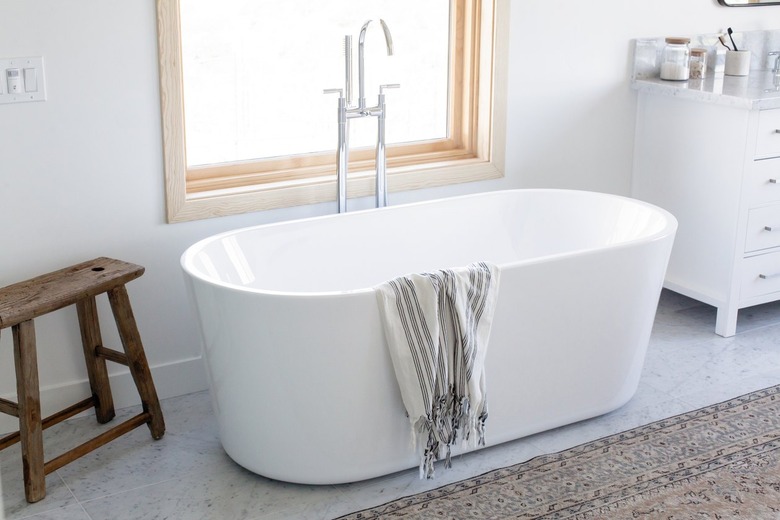What Is The Weight Of A Full Bathtub?
We may receive a commission on purchases made from links.
Bathtubs are heavy, arguably the heaviest thing in your home. If you picked up a new tub today, you'd probably marvel over how light it is compared to how it looks, but that 70-pound shell is just the beginning. It'll have over 200 pounds of water and a human, and then there's whatever mortar is used for stabilizing the base.
When you're renovating a bathroom, gauging a bathtub's weight is important so you can know whether or not your existing floors need to be reinforced to support the weight. Here's what you need to know about how much the average bathtub weighs.
Tip
How much a filled bathtub weighs depends entirely on the tub's capacity, since it can range between 30 and 110 gallons, depending on the design and size. Once you add in a person bathing as well as the tub materials, a filled bathtub can weigh between 500 and 1,500 pounds.
The Weight of Water
The Weight of Water
Each gallon of water weighs 8.34 pounds, so it depends on the volume of the tub in question. Is it a tiny apartment-friendly tub or a gigantic spa-like soaker that washes your cares away? The smallest tubs tend to only have about 40-gallon capacity, but the standard tub size in your average home is the 60-inch long variety. These tend to be around 80-gallon capacity if the tub is on the deeper side. That's roughly 670 pounds for water alone.
Lighter Tub Material Weights
Lighter Tub Material Weights
The weight of a filled tub isn't just about the water — it's about the bathtub itself. There are all kinds of materials available to you today, such as the lighter options in acrylic and vinyl or the heftier ones like cast iron. Each has its appeal and the prices vary widely, just like the weight of the product.
- Plastic tubs: These include both acrylic and vinyl, each of which
has its pluses and minuses. The acrylic tubs weigh a little more, usually around
100 pounds for your standard-size 60-inch tub, but they last 30 years or longer
and offer a smoother finish. - Fiberglass tubs: These tubs cost less, weighs around 70 pounds per
60-inch tub and will give you a life span of around 15 years, but fiberglass tubs are also
thinner and more prone to damage than its sturdier acrylic competitor.
Weight-wise, the differences are negligible. But for a busy young family aiming to put the tub through its paces, acrylic can be a wise choice.
Cast-Iron and Steel Tubs
Cast-Iron and Steel Tubs
Beyond the plastics are heavier hitters, like cast iron and enameled steel.
- Enameled steel: These tubs can look beautiful and weighs about double
the plastic options, in the 150- to 200-pound range. A big drawback for enameled steel tubs is
their tendency to chip and the fact that they pull heat from the water — not a
particularly great quality when you're trying to warm up during a January cold
snap. On the upside, the tub is the least-expensive of all materials and some enameled-steel bathtub models run as little as $150. - Cast iron tubs: These can can weigh far more — the lightest can be as little as 200 pounds, but 400 pounds and higher are common.
They pose installation challenges and can also leach the heat from a bath, but
once the iron warms up, it keeps the water temperature consistent. Plus,
all you have to do is look at how many clawfoot cast-iron tubs are still around
from over a century ago, and you can see that they last a long time, but they're also
easily repaired or restored.
How Much Does a Full Bathtub Weigh?
How Much Does a Full Bathtub Weigh?
Once you're talking water, tub and human, the average bathtub weighs a minimum of 500 pounds and all the way up to a potential 1,500 or more pounds, depending on the model of tub. For lighter tub options, you're probably fine with existing construction, but when installing a heavier, larger tub, reinforcing your floor joists is an option.
